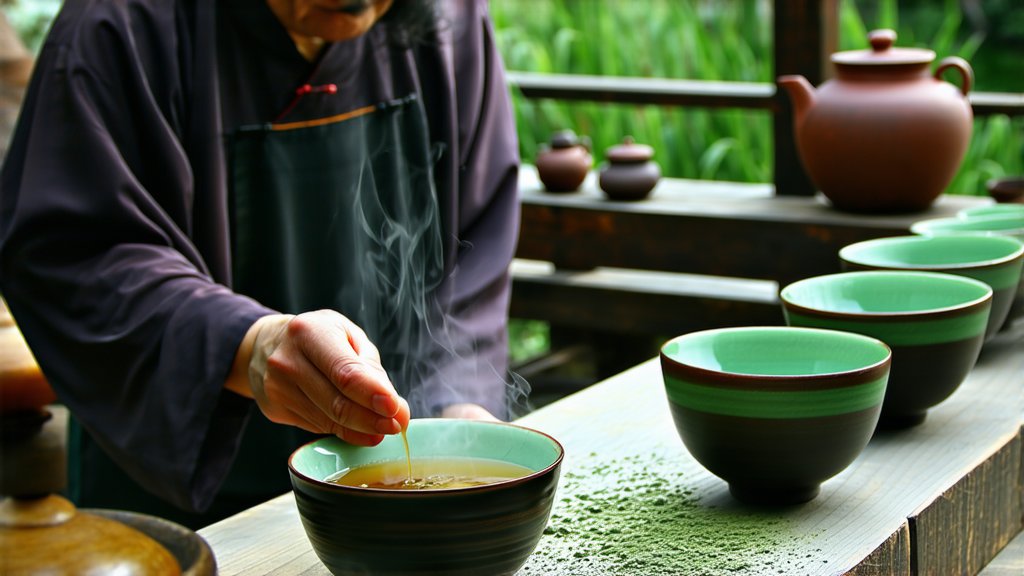
Tieguanyin, also known as Iron Goddess of Mercy, is a revered variety of Oolong tea that hails from the Fujian province of China. This tea is deeply rooted in the rich tapestry of Chinese tea culture, with a history that dates back to the Qing Dynasty. It is named after the Buddhist goddess of mercy, Guanyin, and is celebrated for its ability to soothe and calm the mind, much like the deity it is named after.
Historical Significance
The legend of Tieguanyin's origin is as enchanting as the tea itself. It is said that a poor farmer discovered a tea plant near a Guanyin statue and, after nurturing it, found that the tea produced had extraordinary qualities. The farmer attributed the tea's excellence to the divine intervention of Guanyin, thus naming it Tieguanyin. This story has been passed down through generations, adding a layer of mystique to the tea's already illustrious reputation.
Varieties and Regional Characteristics
Tieguanyin is categorized into two main types based on the region of production: Anxi Tieguanyin and Fujian Tieguanyin. Anxi, a county in Fujian, is particularly famous for its high-quality Tieguanyin. The tea from this region is known for its light, floral aroma and a taste that is both sweet and slightly astringent. Fujian Tieguanyin, on the other hand, is often more robust and has a stronger, more pronounced flavor profile.
Craftsmanship in Tea Making
The制作工艺 of Tieguanyin is a delicate balance of art and science. The process involves several stages: plucking, withering, shaking, fermenting, killing green, rolling, and drying. Each step is crucial in developing the tea's unique characteristics.
- Plucking: The leaves are hand-plucked, typically when they are at the "two leaves and a bud" stage, ensuring the tenderness and freshness of the tea.
- Withering: The leaves are spread out to lose moisture gradually, which helps in the development of the tea's aroma.
- Shaking: This is a unique step where the leaves are gently shaken to initiate the oxidation process, which is what gives Oolong teas their distinct flavor.
- Fermenting: The leaves are allowed to oxidize, which can range from 10% to 70% depending on the desired flavor profile. Tieguanyin is typically partially fermented, giving it a balance between green and black tea characteristics.
- Killing Green: This step stops the oxidation process by heating the leaves, which also helps to fix the tea's color and flavor.
- Rolling: The leaves are rolled to shape them and to further enhance their aroma and flavor.
- Drying: The final step is to dry the leaves, which can be done through sun-drying or using a machine.
Tasting and Appreciation
Tasting Tieguanyin is an experience that engages all the senses. The tea is often served in small, delicate cups called "gaiwans," which are used in the traditional Chinese tea ceremony known as "Gongfu Cha." Here are some aspects to consider when tasting Tieguanyin:
- Aroma: The aroma of Tieguanyin can range from floral and fruity to creamy and nutty, depending on the specific variety and the degree of fermentation.
- Color: The liquor is typically a golden yellow, clear and bright, which is a sign of high-quality tea.
- Taste: The taste is complex, with a balance of sweetness, astringency, and a lingering aftertaste known as "hui gan."
- Texture: The mouthfeel can be smooth and velvety, or it can have a more robust, full-bodied texture.
- Brewing: Tieguanyin can be brewed multiple times, with each infusion revealing different nuances of the tea's flavor.
Cultural Significance and Health Benefits
Tieguanyin is not just a beverage; it is a symbol of Chinese culture and a medium for social interaction. Drinking tea is a ritual that promotes mindfulness and relaxation. The health benefits of Tieguanyin are also well-documented, with studies showing that it can aid in digestion, reduce stress, and have antioxidant properties.
In conclusion, Tieguanyin is a tea that embodies the essence of Chinese tea culture, with its intricate制作工艺, diverse flavors, and profound cultural significance. Whether you are a seasoned tea connoisseur or